A mass for asymptotically complex hyperbolic manifolds
A mass for asymptotically complex hyperbolic manifolds
A mass for asymptotically complex hyperbolic manifolds
Create successful ePaper yourself
Turn your PDF publications into a flip-book with our unique Google optimized e-Paper software.
hal-00429306, version 1 - 2 Nov 2009<br />
A MASS FOR ASYMPTOTICALLY COMPLEX HYPERBOLIC MANIFOLDS. 11<br />
which leads to d |φ| 2 (X) = −2i(X · φ,φ), thanks to lemma 2.4. Differentiating once<br />
more, we find<br />
∇Xd |φ| 2 (Y ) = −2i(Y · ∇Xφ,φ) − 2i(Y · φ, ∇Xφ)<br />
= −(Y · X · φ,φ) + i(Y · JX · ˜ φ,φ) + (Y · φ,X · φ) + i(Y · φ,JX · ˜ φ)<br />
and the result follows from elementary properties of the Clif<strong>for</strong>d product. <br />
At this point, it is useful to introduce the following notations : <strong>for</strong> every Kählerian<br />
Killing spinor φ, we define :<br />
uφ := |φ| 2 , αφ := Jduφ, ξφ(X,Y ) := Im(X · Y · ˜ φ,φ).<br />
Lemma 2.6 — ξφ is a J-invariant two-<strong>for</strong>m satisfying :<br />
∇Zαφ = −2ιZ(ξφ + uφΩ),<br />
(ξφ,Ω) = uφ,<br />
∇Zξφ = − 1<br />
2 (Z ∧ αφ + JZ ∧ Jαφ).<br />
Proof. First, it is easy to check that ξφ is skewsymmetric, as a consequence of the<br />
definition of ˜ φ. The J-invariance of ξφ stems from the following re<strong>for</strong>mulation of its<br />
definition :<br />
ξφ(X,Y ) := Im(X 1,0 · Y 0,1 · ˜ φ,φ) + Im(X 0,1 · Y 1,0 · ˜ φ,φ).<br />
Then <strong>for</strong>mula (9) readily yields<br />
∇Xαφ(Y ) = −2(X,JY )uφ + 2ξφ(JY,JX) = −2uφ Ω(X,Y ) − 2ξφ(X,Y ),<br />
which justifies the first <strong>for</strong>mula.<br />
Let (e1,Je1,... ,em,Jem) be an orthonormal basis. Then we have<br />
(ξφ,Ω) =<br />
m<br />
ξφ(Jek,ek) =<br />
k=1<br />
m<br />
Im(Jek · ek · ˜ φ,φ) = Im(Ω · ˜ φ,φ).<br />
Now we use the spectral decomposition of the action of the Kähler <strong>for</strong>m :<br />
k=1<br />
(Ω · ˜ φ,φ) = (Ω · φl−1 − Ω · φl,φ) = (iφl−1 + iφl,φ) = i |φ| 2 .<br />
This ensures (ξφ,Ω) = |φ| 2 = uφ.<br />
Finally, to obtain the third equation, we introduce θ(X,Y ) := 2(X · Y · ˜ φ,φ) and<br />
differentiate :<br />
∇Zθ(X,Y )<br />
= 2(X · Y · ∇Z ˜ φ,φ) + 2(X · Y · ˜ φ, ∇Zφ)<br />
= i(X · Y · Z · ˜ φ,φ) + (X · Y · (JZ) · φ,φ) + i(X · Y · ˜ φ,Z · φ) − (X · Y · ˜ φ,(JZ) · ˜ φ)<br />
= i([X · Y · Z − Z · X · Y ] · ˜ φ,φ) + ([X · Y · (JZ) − (JZ) · X · Y ] · φ,φ).<br />
The identity ABC − CAB = 2(A,C)B − 2(B,C)A in Clif<strong>for</strong>d algebra leads to<br />
∇Zθ(X,Y )<br />
= 2i(X,Z)(Y · ˜ φ,φ) − 2i(Y,Z)(X · ˜ φ,φ) + 2(X,JZ)(Y · φ,φ) − 2(Y,JZ)(X · φ,φ).


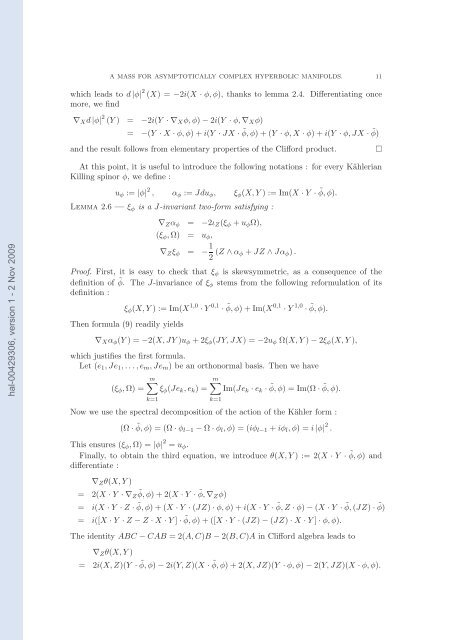



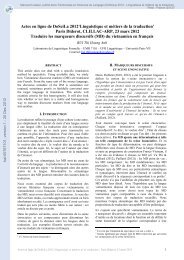
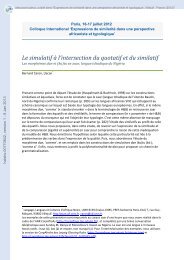
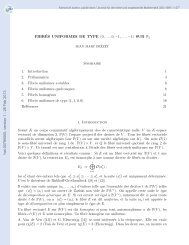
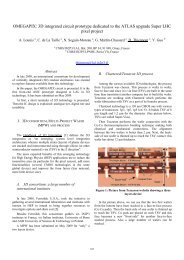
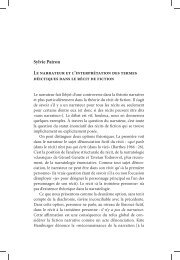
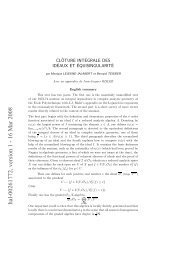
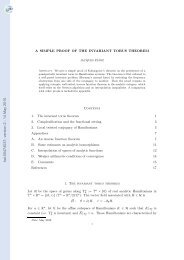

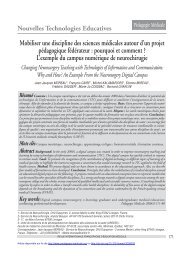

![[tel-00433556, v1] Relation entre Stress Oxydant et Homéostasie ...](https://img.yumpu.com/19233319/1/184x260/tel-00433556-v1-relation-entre-stress-oxydant-et-homeostasie-.jpg?quality=85)